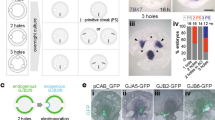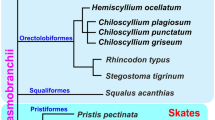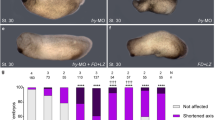Abstract
Fate-mapping experiments in the mouse have revealed that the primitive streak can be divided into three functional regions1: the proximal region gives rise to germ cells and the extra-embryonic mesoderm of the yolk sac; the distal region generates cardiac mesoderm and node-derived axial mesendoderm; and the middle streak region produces the paraxial, intermediate and lateral plate mesoderm of the trunk. To gain insight into the mechanisms that mediate the assembly of the primitive streak into these functional regions, we have cloned and functionally identified the gene disrupted in the amnionless (amn) mouse, which has a recessive, embryonic lethal mutation that interferes specifically with the formation and/or specification of the middle primitive streak region during gastrulation2. Here we report that the gene Amn encodes a novel type I transmembrane protein that is expressed exclusively in the extra-embryonic visceral endoderm layer during gastrulation. The extracellular region of the Amn protein contains a cysteine-rich domain with similarity to bone morphogenetic protein (BMP)-binding cysteine-rich domains in chordin, its Drosophila melanogaster homolog (Short gastrulation) and procollagen IIA (ref. 3). Our findings indicate that Amn may direct the production of trunk mesoderm derived from the middle streak by acting in the underlying visceral endoderm to modulate a BMP signaling pathway.
This is a preview of subscription content, access via your institution
Access options
Subscribe to this journal
Receive 12 print issues and online access
$209.00 per year
only $17.42 per issue
Buy this article
- Purchase on Springer Link
- Instant access to full article PDF
Prices may be subject to local taxes which are calculated during checkout






Similar content being viewed by others
References
Lawson, K.A., Meneses, J.J. & Pedersen, R.A. Clonal analysis of epiblast fate during germ layer formation in the mouse embryo. Development 113, 891–911 (1991).
Tomihara-Newberger, C. et al. The amn gene product is required in extraembryonic tissues for the generation of middle primitive streak derivatives. Dev. Biol. 204, 34–54 (1998).
Larrain, J. et al. BMP-binding modules in chordin: a model for signalling regulation in the extracellular space. Development 127, 821–830 (2000).
Wang, X. et al. A candidate gene for the amnionless gastrulation stage mouse mutation encodes a TRAF-related protein. Dev. Biol. 177, 274–290 (1996).
Xu, Y., Cheng, G. & Baltimore, D. Targeted disruption of TRAF3 leads to postnatal lethality and defective T-dependent immune responses. Immunity 5, 407–415 (1996).
Leung, T., Chen, X.Q., Tan, I., Manser, E. & Lim, L. Myotonic dystrophy kinase-related Cdc42-binding kinase acts as a Cdc42 effector in promoting cytoskeletal reorganization. Mol. Cell. Biol. 18, 130–140 (1998).
De Robertis, E.M., Larrain, J., Oelgeschlager, M. & Wessely, O. The establishment of Spemann's organizer and patterning of the vertebrate embryo. Nature Rev. Genet. 1, 171–181 (2000).
Kolle, G., Georgas, K., Holmes, G.P., Little, M.H. & Yamada, T. CRIM1, a novel gene encoding a cysteine-rich repeat protein is developmentally regulated and implicated in vertebrate CNS development and organogenesis. Mech. Dev. 90, 181–193 (2000).
Matsui, M., Mizusek, K., Nakatani, J., Nakanishi, S. & Sasai, Y. Xenopus kielin: a dorsalizing factor containing multiple chordin-type repeats secreted from the embryonic midline. Proc. Natl. Acad. Sci. USA 97, 5291–5296 (2000).
Conley, C.A. et al. Crossveinless 2 contains cysteine-rich domains and is required for high levels of BMP-like activity during the formation of the cross veins in drosophila. Development 127, 3947–3959 (2000).
Yu, K. et al. Processing of the Drosophila Sog protein creates a novel BMP inhibitory activity. Development 127, 2143–2154 (2000).
Oelgeschlager, M., Larrain, J., Geissert, D. & De Robertis, E.M. The evolutionarily conserved BMP-binding protein Twisted gastrulation promotes BMP signalling. Nature 405, 757–763 (2000).
Kopczynski, C.C. et al. A high throughput screen to identify secreted and transmembrane proteins involved in Drosophila embryogenesis. Proc. Natl. Acad. Sci. USA 95, 9973–9978 (1998).
Gu, Z. et al. The type I serine/threonine kinase receptor ActRIA (ALK2) is required for gastrulation of the mouse embryo. Development 126, 2551–2561 (1999).
Mishina, Y., Crombie, R., Bradley, A. & Behringer, R.R. Multiple roles for activin-like kinase-2 signaling during mouse embryogenesis. Dev. Biol. 213, 314–326 (1999).
Coucouvanis, E. & Martin, G.R. BMP signaling plays a role in visceral endoderm differentiation and cavitation in the early mouse embryo. Development 126, 535–546 (1999).
Zhang, H. & Bradley, A. Mice deficient for BMP2 are nonviable and have defects in amnion/chorion and cardiac development. Development 122, 2977–2986 (1996).
Edelhoff, S. et al. Mapping of two genes encoding members of a distinct subfamily of MAX interacting proteins: MAD to human chromosome 2 and mouse chromosome 6, and MXII to human chromosome 10 and mouse chromosome 19. Oncogene 9, 665–668 (1994).
Godwin, A.R., Stadler, H.S., Nakamura, K. & Capecchi, M.R. Detection of targeted GFP-Hox gene fusions during mouse embryogenesis. Proc. Natl. Acad. Sci. USA 95, 13042–13047 (1998).
Tybulewicz, V.L., Crawford, C.E., Jackson, P.K., Bronson, R.T. & Mulligan, R.C. Neonatal lethality and lymphopenia in mice with a homozygous disruption of the c-abl proto-oncogene. Cell 65, 1153–1163 (1991).
Rossi, G., Salminen, A., Rice, L.M., Brunger, A.T. & Brennwald, P. Analysis of a yeast SNARE complex reveals remarkable similarity to the neuronal SNARE complex and a novel function for the C terminus of the SNAP-25 homolog, Sec9. J. Biol. Chem. 272, 16610–16617 (1997).
Katz, L., Hanson, P.I., Heuser, J.E. & Brennwald, P. Genetic and morphological analyses reveal a critical interaction between the C-termini of two SNARE proteins and a parallel four helical arrangement for the exocytic SNARE complex. EMBO J. 17, 6200–6209 (1998).
Manova, K. et al. c-kit receptor and ligand expression in postnatal development of the mouse cerebellum suggests a function for c-kit in inhibitory interneurons. J. Neurosci. 12, 4663–4676 (1992).
Acknowledgements
We thank K. Anderson, L. Niswander, P. Wilson, C. Blobel and F. Costantini for discussions and critical reading of the manuscript; J.-H. Dong, J. Ingenito, R. Lester and W. Mark for technical expertise and advice; Y. Zhang and M. Grunwald for technical assistance; J. Choi for his contribution to database analyses; R. Rivi and F. Lupu for discussions and critical reading of the manuscript; and R. Yeung for assistance in the generation of the Amn polyclonal antisera. This work was supported by NIH grant GM58726 (E.L.) and the MSKCC Support Grant CA-08748.
Author information
Authors and Affiliations
Corresponding author
Rights and permissions
About this article
Cite this article
Kalantry, S., Manning, S., Haub, O. et al. The amnionless gene, essential for mouse gastrulation, encodes a visceral-endoderm–specific protein with an extracellular cysteine-rich domain. Nat Genet 27, 412–416 (2001). https://doi.org/10.1038/86912
Received:
Accepted:
Issue Date:
DOI: https://doi.org/10.1038/86912
This article is cited by
-
Imerslund-Gräsbeck syndrome: a comprehensive review of reported cases
Orphanet Journal of Rare Diseases (2023)
-
Human Chorionic Gonadotropin Improves the Proliferation and Regenerative Potential of Bone Marrow Adherent Stem Cells and the Immune Tolerance of Fetal Microchimeric Stem Cells In Vitro
Stem Cell Reviews and Reports (2020)
-
Loss of Cubilin, the intrinsic factor-vitamin B12 receptor, impairs visceral endoderm endocytosis and endodermal patterning in the mouse
Scientific Reports (2019)
-
Multi-omics profiling of mouse gastrulation at single-cell resolution
Nature (2019)
-
Novel compound heterozygous mutations in AMN cause Imerslund-Gräsbeck syndrome in two half-sisters: a case report
BMC Medical Genetics (2015)



